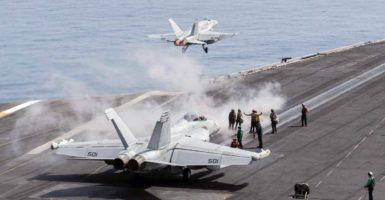One of the greatest challenges to American interests abroad is in keeping the world’s oceans open to commerce and activity. From Russia dominating the Black Sea to China constructing man-made islands in the South China Sea, it is apparent the U.S. Navy must be prepared for growing threats.
“For the first time in 25 years, the Navy is facing a return to great power competition at sea.”
This was how Rear Adm. Michael C. Manazir, deputy chief of Naval Operations for Warfare Systems, assessed the maritime security environment at a recent hearing on aviation readiness before the House Armed Services Committee. And while he expressed confidence that the U.S. Navy will continue to meet this challenge in the near future, the long-term outlook will be more concerning if the sea service does not receive more robust funding for rebuilding and maintaining its fleet.
Manazir presented a multifaceted initiative to sustain the Navy’s global presence that protects U.S. citizens and interests around the world, with an eye toward continuing the success of the Optimized Fleet Response Plan.
The Navy developed the plan in recent years to mitigate shortfalls in the fleet while preserving the readiness of each vessel and crew. As Manazir explained, this plan allowed the USS Harry S. Truman carrier strike group to successfully deploy to the Middle East this year.
The Truman carrier strike group returned from an eight-month deployment on July 13 after its air wing dropped 1,598 bombs and logged 20,788 flight hours, both records for carrier strike group operations.
Of particular strategic advantage was the Truman’s position operating from the eastern Mediterranean, a region where carrier strike groups have not operated since the start of Operation Iraqi Freedom in March 2003, because the fleet was stretched too thin.
This recent successful operation lent urgency to Manazir’s call “to maximize the employability of our operational units for both presence and contingency response” by meeting the fleet response plan requirements crucial to keeping the service ready to fight and win, efforts that will be increasingly strained in the future unless the Navy receives more funding to grow and maintain its fleet.
According to Manazir, the future readiness of naval aviation for operations abroad hinges on three key capabilities: getting fleet units ready for deployments; being able to surge the fleet in times of war and resetting it afterward; and sustaining maintenance and modernization programs that ensure maximum service life for fleet units, platforms, and equipment.
Fleet Readiness Centers and aviation depots, the facilities at which ships and aircraft undergo maintenance, are underfunded, fueling a current cyclical roadblock to achieving these tenets of naval aviation.
For example, without sufficient resources, the readiness centers and depots have had to execute a hiring freeze and implement overtime restrictions on maintenance personnel, effectively draining both manpower and expertise. This backlog has strained the centers even more amidst demands to reset after more than a decade of combat operations in Iraq and Afghanistan.
Though recent budget activity enabled the Navy to address some of these issues, the “workforce behind our public and private depots is no longer sufficient for emergent projects,” Manazir said. This insufficiency is the result of inadequate funding, further strained by a global threat environment that continues to demand a high level of naval presence.
In implementing the Optimized Fleet Response Plan, the Navy had to make a choice between immediately expanding its presence around the world and preserving the undersized fleet farther into the future by strictly managing deployment schedules.
They responsibly chose the latter, but with global threats ranging from Russia’s increased maritime activity in the Arctic to China’s aggressive actions in the South China Sea, a larger, globally positioned U.S. Navy is increasingly necessary to protect America and its interests.
Congress can better fulfill its constitutional responsibility to provide for the common defense and provide and maintain a Navy by more robustly investing in the growth and maintenance of its fleet.





























